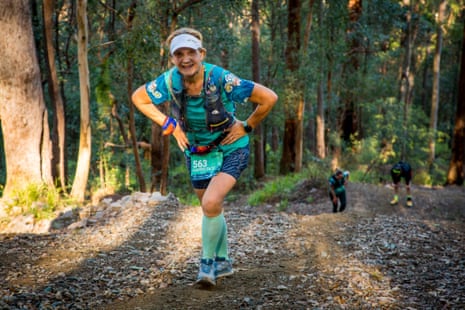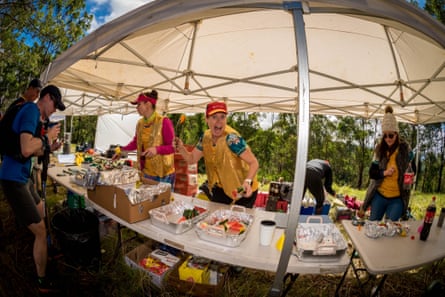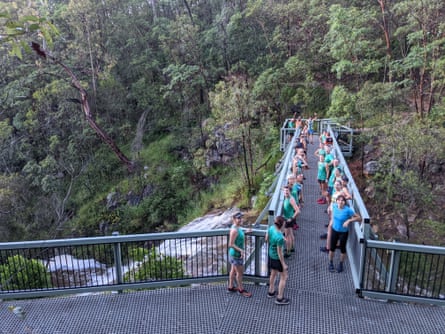
If you can walk on it, you can run on it: a beginner’s guide to trail running
More meditative and less repetitive than road running, trail running offers fitness with a view. And the chances of injury are lower than you might expect
Jumping over tree roots and slogging up steep slopes may not sound like everyone’s cup of tea, but a growing number of Australians are pounding dirt instead of pavement, taking their exercise (and social lives) to the trails.
You may have stood to the side for them while bushwalking, pausing patiently as cheery folk with strange little backpacks trot past. Or perhaps an algorithm has fed you some idyllic shots of sweaty people on mountain tops or winding their way through a forest.
Australia’s trail running events calendar is increasingly packed, with more than 200 runs around the country from now until the end of winter alone. There are more clubs and social groups than you could poke a hiking pole at, and, of course, the scenery is beautiful.
Most assuringly for beginners, you’re allowed to walk before you run. “People don’t realise that it’s okay to walk and it’s encouraged,” says Megan Brown, a trail and ultra runner and coach based in Brisbane. “And sometimes it’s actually more efficient to hike a hill [instead of] running it.”
What is trail running?
Any unpaved natural surface can be a trail run, but often there are a good dose of hills. Those are the two main environmental differences from road running. Trails can range from gentle, meandering walking paths to narrow rocky traverses, from sandy beaches to snowy summits.
Brown says a trail run is more about going for an adventure than a typical road run: you have to watch your footing.
“You do need to be much more alert with the rocks and roots, the ups and the downs, and picking your feet up,” she says.
Initially it can be mentally draining “because you have to stay so focused”.
“But then once you get into a rhythm and get your confidence levels up, it’s probably more meditative … you’re out in nature, you’ve got the birds, it’s quite peaceful.”
Getting started
Brown says the best way to build your confidence is to explore a short, local trail that you can run out and back on.
If you can walk on it, you can run on it. National and state parks are good places to find trails, but large urban parks often have networks of dirt trails running through them too.
Brendan Davies, an Athletics Australia running coach based in the Blue Mountains, says that even if you’re already a runner, the varied and sometimes unpredictable terrain will affect your body differently.

On a trail the impact is shared across more muscles and ligaments, which can actually reduce injury risk. “You move sideways a lot in trail running, to stabilise yourself,” Davies says. “Because you’re going up and down, you’re switching muscle groups continually.” This means the repetitive strain injuries many road runners develop are less likely.
“Sure you can get injuries like twists, ankles rolling and things like that. But even that decreases the longer you train on trails as well, because all the ligaments and tendons get stronger.
But he says it is important beginner trail runners don’t try to “bite off too much too soon”.
“It’s just about starting small – small distances and on easy, familiar terrain. So your body can get used to it before you try to step it up to the next level.”
You won’t need new shoes either, says Laura Coles, owner of specialist trail running store the Trail Co. If you already own regular road running shoes, it is fine to start with those, then upgrade to specialised gear later on.
Kitting up
While the cost of entry to trail running is low, it can quickly increase if you get more adventurous – or develop a taste for the latest tech.
“Once you’ve decided you want to stick with it, it is good to get some trail runners,” says Coles. “They will make you more comfortable and your road shoes won’t get worn down.”
Davies suggests starting with a pair of all-round trail shoes “well fitted for your foot and your gait” with “reasonable grip”.
“[Trail shoes] are usually developed to drain water a bit better and have a more robust outer, so they can handle being knocked around a bit more.”
Davies suggests bringing your phone and a small first aid kit whenever you’re running away from residential areas.
READ RELATED: Weekend podcast: Nicolas Cage, Marina Hyde on David Cameron’s return, plus cardiologists’ advice for a healthy heart
“I rarely would go out for a run in the bush without a snake bandage,” he says. “Even if it is just half an hour, you never know. You just have to cover worst-case scenarios.” You can get snake bandages starting from around $10 from pharmacies – but make sure you know how to use them first.
after newsletter promotion
Once you start running for longer, or in more remote areas, you’ll need somewhere to put your first aid, water, food and clothes. That’s where vests and belts come in. A running vest is a small fitted backpack that won’t bounce around too much when you run where you can stash trail snacks. Prices start from around $100.
Coles says there are loads of choices for food on the move, including gels and “powdered nutrition in your water to give you energy while you drink”.
“But other people can’t stand that,” she says. “If you don’t want to get into all the technical stuff, you could just take a Vegemite sandwich.”
How to train
You may not need to do trail-specific training at first, but as soon as you start pushing the distances and getting more technical and steep, you will need to prepare your body more, says Davies – especially if you don’t live in the mountains.
“If you’re living in the city, and you want to come up to the mountains and run trail running races, you have to supplement your road running with some extra gym work,” he says. “Maybe a couple of sessions a week, focusing on your lower body and core.
“Find places where you can train that will simulate running up a hill: so, stairs [and] doing hill rep sessions. It’s all about getting comfortable hiking up a hill first.”
And don’t forget to hone your downhill running technique too.
Finding running mates
One of the best ways to get started trail running is to find a group to go with, because, as Coles says, trail running has “a big community”.
“I think because you do have to go a bit slower … you end up chatting,” she says.

Coles is a race director and says she sees teenagers right through to runners in their 70s. “It’s a very welcoming sport.”
If you don’t have access to transport, joining a tour can take the logistics out of your hands, and they usually offer vests and hiking poles for hire.
Like tours, races can keep you on the right path, provide a supportive environment to run in, and sometimes open up areas that aren’t normally accessible. Brown says signing up for a race can “give you something to aim for that keeps you going out on the rainy days, or the days when you’re feeling a bit flat”.
Added bonuses are the party at the finish line, a medal, and maybe even lifelong connections. Brown even met her husband at a trail event.
“We were on the run and I asked him if he had anything for chafing,” she says. “He handed me his body glide, then I proceeded to rub it all over my inner thighs. You could say it was love at first sight.”
Beginner-friendly race events
Ultra-Trail Australia, May, New South Wales
The southern hemisphere’s biggest trail running event has a 11km option if you want to get in on the action. You’ll be eyeing off the 22km in no time.
Perth Winter Trail Series, May through August, Western Australia
This series offers four races in the Perth hills, each with multiple distances ranging from 4km to 50km.
South-east Queensland Trail Running Series, October through to March, Queensland
This series of races around south-east Queensland has short and long options and no pressure on finish times. You can enter one event to see if you like it or sign up for the lot.
Warburton Trail Festival, March, Victoria
This multi-day event in the fern-covered hills north-west of Melbourne has a 5km and 9km option. Plus, if you’re after something silly, there’s the lilo derby: floatation device required, dress-ups encouraged.
Source: Health & wellbeing | The Guardian




